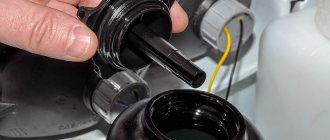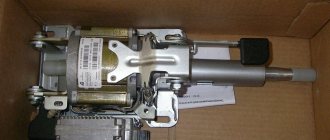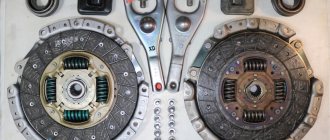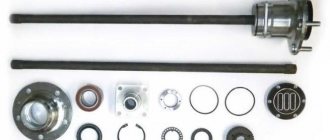Operating principle of power steering
The operation of the hydraulic booster is based on the transmission of pressure by liquid. This pressure can exert forces on parts of the steering mechanism, thereby reducing steering effort. The entire design of the power steering is aimed at creating high pressure in the fluid. This pressure is created in the working line, which opens when the steering wheel is turned. The force is transmitted to the hydraulic cylinder of the steering rack or steering mechanism, and then to the steering rods. As a result of the power steering, the driver feels barely noticeable resistance on the steering wheel, which allows you to control the car in difficult road conditions.
Power steering pump
The power steering pump can be called the main unit, since it is it that pumps fluid, creating increased pressure in the line. The main element of the pump is the impeller, which is driven into rotation by a belt drive. Unfortunately, many power steering malfunctions are associated precisely with pump failure. Liquid starvation is unacceptable.
The driver must carefully monitor the fluid level, since air entering the pump leads to accelerated wear.
The presence of air can be recognized by a sudden increase in the force on the steering wheel, as well as a characteristic buzzing sound when turning the steering wheel. Bleeding the line is a standard procedure and is carried out by turning the steering wheel in one direction or the other.
The next problem is wear of the shaft bearing. The fact that the bearing has become unusable is indicated by extraneous sounds emitted from the pump when the engine is running. To verify this, just remove the drive belt and start the car. If the sounds disappeared, then the reason was in the pump. The situation can be corrected by replacing the shaft bearing.
Fluid replacement
If you need to change the power steering fluid for a Niva Chevrolet, you can do it as follows:
- Unscrew the coupling bolt and unscrew the cover
- The reservoir is removed from the bracket and the clamp that secures the power steering outlet hose is loosened.
To prevent liquid from flowing out during filling, you need to plug the hole in the barrel fitting, lower the outlet hose end into a container where the waste will be drained. We start the engine and begin to rotate the steering wheel, while adding new fluid and draining the old one, the steering wheel must be turned in different directions four times. After this, we install the tank in its place, reconnect all the hoses and add new fluid to the required level.
Leveling up
After replacement, bleed the system as follows:
- Set the steering wheel to the middle position
- Start the engine for 30 seconds and turn it off, without turning the steering wheel.
- When the engine is turned off, the steering wheel must be turned all the way in any direction.
- The exhaust valve has a protective cap that needs to be removed
- Turn the steering wheel all the way in the other direction, at this time air should come out through the valve, after which liquid will flow
- Close the cap back.
- Add oil, start the engine, turn the steering wheel back all the way, turn off the engine.
- Add oil to the top mark
At this point, the pumping work can be considered completed.
Rotary valve
High pressure in the line must be controlled, otherwise the fluid will exert force in only one direction. A rotary valve is used to distribute the liquid along the line. To be more precise, there are several of them. When the steering wheel is turned, the valve opens that part of the line that corresponds to the given direction of movement of the rack rod. Usually, throughout the entire period of operation, the valve does not cause any problems, but for this it is necessary to periodically change the power steering fluid according to the established regulations, otherwise the valve may become clogged.
Bleeding the power steering system on VAZ 2121, 2131
Procedure:
- Add oil to the power steering reservoir to the lower mark.
- We start the engine and at idle speed, check the oil level in the tank. If necessary, top up to the lower mark.
- Turn the steering wheel left and right as far as it will go several times and check the oil level in the tank. If necessary, top up to the lower mark.
- Remove the protective cap from the bleeder fitting.
- We loosen the tightening of the bleeder fitting (key “8”).
- We connect a transparent hose to it, the other end of which is lowered into an empty container.
- Unscrew the fitting 1/2 turn.
- When a continuous flow of liquid without air bubbles appears in the hose, tighten the fitting.
- Set the steering wheel to the middle position and let the engine run for another 2-3 minutes.
- Turn the steering wheel left and right as far as it will go several times and check the oil level in the tank. If the level drops again, then repeat steps 4-9.
Let us remind you that you can look for other instructions for car repair and operation in the appropriate categories (Lada XRAY, Largus, Priora or Lada 4×4).
Keywords: lada xray steering wheel | Lada Largus steering wheel | Lada Priora steering wheel | 4x4 steering wheel | steering gear Lada Xray | steering mechanism Lada Largus | steering mechanism Lada Priora | steering gear 4x4 | Niva steering wheel | steering gear Niva | universal article
0
Share on social networks:
Found an error? Select it and press Ctrl+Enter..
Steering gear
The steering mechanism performs two functions simultaneously. First, it converts steering wheel rotation force into bipod rotation force. In essence, the rotation axes rotate. Hydraulic fluid transmits force to a power cylinder connected to the bipod sector. The most common malfunction of the mechanism is associated with a leak in the high pressure line connection fitting. Typically, repairs come down to replacing the fitting along with the main hose.
The power steering can serve properly for a long time.
The main requirement is to change the fluid in a timely manner and monitor the tightness of the system.
Bleeding the power steering system of Niva Chevrolet (VAZ 2123)
Bleeding the power steering system is necessary when replacing fluid, as well as to remove air that has entered the hydraulic drive when repairing or replacing individual components of the system. To bleed the hydraulic system, open the power steering reservoir cap and add fluid to the lower mark on the reservoir cap indicator. We start the engine and at idle speed check the fluid level in the tank. If the liquid level drops, add it to the lower mark. We turn the steering wheel left and right several times until it stops, making sure that the fluid level in the tank is at the lower mark. Remove the protective rubber cap from the bleeder fitting.
The bleeder fitting is located on the steering gear cover.
We put a transparent hose on the head of the fitting, lowering its free end into the vessel. Using the “8” wrench, unscrew the fitting 1/2 turn. When a continuous stream of liquid appears in the hose, tighten the fitting. We return the steered wheels to the straight-line position of the car and let the engine run for another two to three minutes. Normal operation of the hydraulic booster should not be accompanied by noise. Turn the steering wheel all the way left and right again and, if necessary, add fluid to the tank to the bottom mark. After warming up and stabilizing the temperature of the working fluid, its level should be at the upper level, and in a cold state not fall below the minimum level.
Pumping power steering Niva Chevrolet
Bleeding the power steering system of Niva Chevrolet (VAZ 2123)
Bleeding the power steering system is necessary when replacing the fluid, as well as to remove air that has entered the hydraulic drive during the repair or replacement of individual components of the system. To bleed the hydraulic system, open the power steering reservoir cap and add fluid to the lower mark on the reservoir cap indicator. We start the engine and at idle speed check the fluid level in the tank. If the liquid level drops, add it to the lower mark. We turn the steering wheel left and right several times until it stops, making sure that the fluid level in the tank is at the lower mark. Remove the protective rubber cap from the bleeder fitting.
The bleeder fitting is located on the steering gear cover.
We put a transparent hose on the head of the fitting, lowering its free end into the vessel. Using the “8” wrench, unscrew the fitting 1/2 turn. When a continuous stream of liquid appears in the hose, tighten the fitting. We return the steered wheels to the straight-line position of the car and let the engine run for another two to three minutes. Normal operation of the hydraulic booster should not be accompanied by noise. Turn the steering wheel all the way left and right again and, if necessary, add fluid to the tank to the bottom mark. After warming up and stabilizing the temperature of the working fluid, its level should be at the upper level, and in a cold state not fall below the minimum level.
Power steering hoses for Niva Chevrolet. Recall campaign?
Changing Power Steering Oil
Power steering for VAZ-2121 Niva (Video from subscriber)
how to bleed the power steering system of a chrysler voyager
Changing power steering oil
REPLACING POWER POWER FLUID VAZ-2110, 2111, 2112 PRIORA,KALINA,GRANT
Repair and maintenance of Chevrolet Niva: how to find out the fluid level in the power steering
Chevrolet Niva maintenance, oil change, filters
Turn (rotate) the steering wheel in place. Consequences. Power steering or electric power steering errors by drivers. Suspension diagnostics 3h
How to change oil in power steering (power steering) VAZ
Loosen the clamp securing the outlet hose and remove the hose.
Repair and maintenance of Chevrolet Niva: how to find out the fluid level in the power steering
Use a syringe with a tube to remove as much old oil as possible from the tank.
To prevent power steering fluid from leaking out, plug the hole in the reservoir fitting, lower the end of the outlet hose...
We remind you once again to keep the Chevrolet Niva power steering system functioning for as long as possible, avoid long-term fixation of the steering wheel in the extreme position when driving, and do not park the car with the steering wheel turned all the way. During operation, Chevrolet Niva power steering fluid can leak in various places, most often through hoses. After which it becomes possible to remove the tank plug.
This must be done until air bubbles stop escaping into the tank.
Power steering pump Niva Chevrolet for BMW 5 engine N52
But if there is damage to the steering rack, oil and dirt may enter the system. As a result, traces of contamination can be seen in the expansion tank. Also, power steering fluid, like all fractional mixtures, can form a sediment of components over time, which affects its quality and requires replacement.
In practice, it is necessary to change it every six years, regardless of its condition, since the temperature difference between winter and summer negatively affects its condition. Recently, the manufacturer has been abandoning such labels, so it is necessary to identify the brand by color.
To replace, the bracket bolt is unscrewed.
After which it becomes possible to remove the tank plug. The tank can be removed from the bracket to drain the liquid into a specially prepared container. After this, you can loosen the clamp of a suitable hose to remove the tank.
To prevent liquid from flowing out, it is necessary to close the hole in the tank fitting, after which you need to lower the end of the hose to drain it into a container to drain the liquid. Then you need to start the engine and turn the steering wheel in different directions until it stops.
Chevrolet Niva bleeding the power steering system
If the power steering fails, it is possible to drive the car, but the steering wheel will be difficult to turn and will become heavy. During operation, Chevrolet Niva power steering fluid can leak in various places, most often through hoses.
As a result, the power steering oil level will drop. Driving without fluid in the Chevrolet Niva's power steering puts you at risk of breaking the power steering pump, which costs a lot of money, since it will run dry.
As a result, it will suffer serious damage and fail. Intensive use of the Chevrolet Niva makes the color of the power steering oil darker over time, often with a burning smell. This is a reason to think about replacing it. Overheating of the oil often occurs when the steering wheel is held in the extreme position for a long time, until it boils; the pressure in this case is maximum.
You should also not leave your car parked for a long time with the steering wheel turned all the way.
see also
Characteristics of Dextron 2 and 3 - what are the differences
- 38 1 29k
Power steering malfunctions
- 22 0 33k
What kind of oil to fill in power steering
- 160 0 214k
Power steering buzzes
- 360 7 331k
15 best power steering fluids
- 122 13 371k
Bleeding the power steering and its system is carried out when replacing the working fluid, airing, which may be the result of a malfunction or repair work. Air trapped inside not only reduces the efficiency of the power steering, but can also cause serious damage, in particular, failure of the power steering pump. Therefore, pumping the hydraulic booster must be carried out in strict accordance with existing technology.
We pump the power steering with our own hands
However, there are exceptions when automakers adjust the pumping process, trying to make it more convenient and simpler. With the instruction manual at hand, be sure to look at the correct section. There you will find everything you need related to the hydraulic booster installed specifically on your vehicle.
It is on them that I propose to place the main emphasis. This will give you the opportunity to understand what to do and what to build on when planning to bleed the power steering on your own car.
Having released one of the taps on the tank, a hose connected to an empty plastic bottle is connected to it. It is there that the hydraulic mixture from the power steering system will subsequently be drained. This is the simplest and most common scheme.
To make it easier for you to pump out the bulk of the old fluid, you can use a syringe. As soon as a minimum volume of hydraulics remains in the reservoir, which can no longer be pumped out with this device, you can move on to the next stage. Namely, fill in new fluid to the upper mark on the expansion tank.
Please note that the new hydraulic oil will now displace the old one. Monitor the level carefully and try not to allow air to enter the system through the hose.
Further actions
We have already managed to cover about half the distance together. As you can see, nothing complicated yet. Everything can be done with your own hands, without having any special skills or deep knowledge.
After completing all the previous steps, follow these steps:
- if the liquid level in the expansion tank has dropped, add oil;
- start the engine for literally 3 seconds and turn it off;
- the liquid will begin to spread throughout the system;
- add oil to the MAX mark and repeat the procedure with the internal combustion engine;
- such a cycle usually requires 3-5 repetitions;
- you need to stop pumping when air stops escaping into the drain bottle;
- if clean hydraulics without bubbles enter the container, there is no air left in the system;
- return the return hose to its place;
- if necessary, add oil to the maximum mark;
- start the engine;
- slowly turn the steering wheel left and right until it stops 4-5 times;
- Having turned the steering wheel all the way, stop for 2-3 seconds and turn in the opposite direction;
- if there is remaining air, it will enter the expansion tank;
- Make sure that the power steering pump does not create any extraneous noise when pumping;
- as soon as air bubbles stop appearing on the surface of the power steering fluid in the tank, pumping is completed;
- Screw the reservoir cap tightly.
But increasingly, automakers are abandoning this scheme due to the low efficiency of the pumping procedure.
It is optimal if, upon completion of the procedure, the oil in the power steering expansion tank is between MIN and MAX. This is due to the property of a liquid to expand when heated. Therefore, it is not recommended to fill the oil all the way.
The question is purely individual. It depends on your skills, capabilities and desire to save. The cost of the working fluid itself for power steering depends on many parameters, and therefore prices vary from 4 to 15 dollars per 1 liter. In total, pumping and replacement will require from 1 to 3 liters.
Bleeding the power steering cannot be called difficult. Many inexperienced car owners easily perform this work.
It is only important to follow the manufacturer's recommendations and use high-quality fluid suitable for your specific power steering
How to pump power steering
How to fill oil and bleed power steering
The procedure for replacing fluid and pumping power steering is carried out in strict accordance with the existing algorithm. Some automakers may add their own features to it. If you have a manual for your car, we recommend that you read the relevant section. In general terms, the steps must be performed in the following sequence:
- Raise the vehicle completely on a lift or with the front wheels off the ground.
- If necessary, drain the old fluid from the expansion tank. To do this, remove the return hose (going to the power steering system) from the expansion tank and put a plug on it so that liquid does not spill out of the hose. A hose leading to an empty bottle is connected to the released tap on the tank, where the old hydraulic fluid is supposed to be drained.
- It is most convenient to pump out the main volume of liquid with a syringe and pour it into a separate bottle. When there is very little liquid left, move on to the next point.
- Fill the expansion tank with working fluid to the top.
- Next, you should turn the steering wheel from side to side (from lock to lock) several times so that the old fluid remaining in the system flows out through the hose. Since the new fluid displaces the old, do not forget to monitor the oil level in the tank so that air does not get into the hose.
- If the fluid level drops, add it again.
- Start the engine for 2-3 seconds and turn it off. This is done so that the liquid begins to spread throughout the system.
Pumping out oil with a syringe
- Next, add working fluid to the tank to the MAX level and repeat the procedure by starting the engine. Repeat this cycle 3-5 times.
- The signal to stop pumping is the fact that air from the return hose stops entering the drain bottle. This means that there is no more air left in the hydraulic system and fresh, clean fluid enters the reservoir.
- After this, you need to reinstall the return hose (connect it to the expansion tank where it was originally installed).
- Refill the reservoir to the MAX level, then start the engine.
- To pump the hydraulic booster, you need to slowly turn the steering wheel 4-5 times from the left to the right stop. At the stop points, pause for 2-3 seconds. If there is any air left, it should escape into the expansion tank. During the inspection process, we make sure that the pump does not make any extraneous noise.
- An indicator that pumping has ended will be the absence of air bubbles on the surface of the liquid in the tank.
- After this, close the expansion tank tightly.
Bleeding the power steering system
can also be pumped without starting the engine , “cold”. To do this, just rotate the steering wheel from the left to the right stop . At the same time, old fluid and air leave the system. However, most automakers still recommend bleeding the system with the engine running.
Chevrolet Niva Manual
Bleeding the power steering system is necessary when replacing fluid, as well as to remove air that has entered the hydraulic drive when repairing or replacing individual components of the system. To bleed the hydraulic system, open the power steering reservoir cap and add fluid to the lower mark on the reservoir cap indicator. We start the engine and at idle speed check the fluid level in the tank. When the liquid level drops, add it to the lower mark. We turn the steering wheel left and right several times until it stops, making sure that the fluid level in the tank is at the lower mark. Remove the protective rubber cap from the bleeder fitting.
The bleeder fitting is located on the steering gear cover. We put a transparent hose on the head of the fitting, lowering its free end into the vessel. Using the “8” key, unscrew the fitting 1-2 turns. When a continuous stream of liquid appears in the hose, tighten the fitting. We return the steered wheels to the straight-line position of the car and let the engine run for another two to three minutes. Normal operation of the hydraulic booster should not be accompanied by noise. Turn the steering wheel all the way left and right again and, if necessary, add fluid to the tank to the bottom mark. After warming up and stabilizing the temperature of the working fluid, its level should be at the upper level, and in a cold state not fall below the minimum level.
0 0 votes
Article rating
Typical power steering malfunctions
Malfunctions in the operation of the hydraulic booster can be easily identified by characteristic signs. Among them:
- The steering wheel turns hard . Probable causes are failure of the power steering pump, use of unsuitable working fluid, sticking of the spool mechanism channels.
- , a high-frequency sound (similar to a whistle) is heard while driving The probable cause is a loose drive belt.
- The steering wheel turns jerkily . Probable causes of the malfunction are the working fluid not meeting the specifications declared by the manufacturer, a malfunction of the fluid distributing mechanism, or a pump malfunction.
- The presence of intense foaming in the expansion tank. Probable causes are mixing of different types of fluids, failure of the power steering pump.
- When the engine is running, the steering wheel spontaneously turns in any direction . The probable cause is malfunction of the spool mechanism, most often, clogging of its working channels, incorrect assembly (for example, after installing a repair kit).
Recommendations for operation and maintenance of power steering
In order for the power steering and its system to operate normally, as well as to extend their service life, you must adhere to several simple rules:
- use working fluids recommended by the automaker , and also replace them in a timely manner (most automakers recommend replacing power steering fluid every 60.120 thousand kilometers, or once every 2 years, it depends on the driving style and intensity of use of the car);
- carry out bleeding of the power steering system in strict accordance with the algorithm described above (or observing individual requirements, if any are set by the car manufacturer);
- monitor the condition of the steering rack boot , because if it is torn, dust and dirt will enter the system, which leads to the power steering pump exiting. A sign of a problem that has already occurred is the hum of the power steering, which is not eliminated even by replacing the fluid.
Cost of replacing fluid and pumping power steering
If you plan to carry out work on replacing the fluid and pumping the power steering yourself, then you will only need to buy oil in a volume of 1 to 3 liters (including flushing, while the volume of the power steering system of a passenger car is up to 1 liter). The price of the liquid depends on the brand and store. It is within $4.15 per liter. If you do not want or cannot carry out such work yourself, contact a service station for help. Approximate prices for January 2021 are:
- fluid replacement work - 1200 rubles;
- power steering pumping - 600 rubles.
Bleeding the power steering system
To bleed the power steering system on a Niva, you need to set the steering wheel to the middle position and start the engine for a few seconds without turning the steering wheel. After this, you need to turn off the car and turn the steering wheel all the way in any direction.
Then the protective cap is removed from the special valve and, using a wrench, it is turned to bleed any remaining air from the system.
Then you need to turn the steering wheel in the other direction, leaving the air bleed valve open. An air plug and some liquid will come out of it, after which the valve must be closed. If necessary, the mixture is added to the power steering to the maximum mark. Then you need to start the engine and turn the wheel from side to side until it stops. This must be done until air bubbles stop escaping into the tank. If necessary, the mixture is topped up again to the required level.











